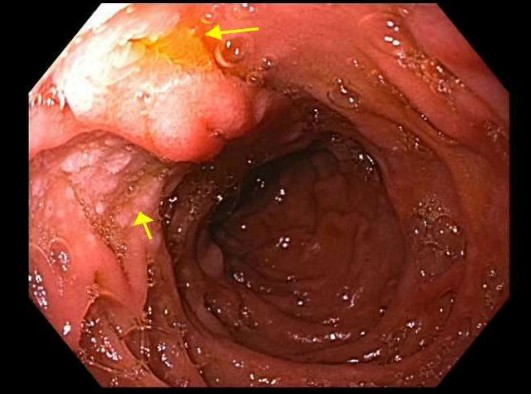Sunday Poster Session
Category: Small Intestine
P2016 - Watching and Waiting: A Call for Surveillance Guidelines in Duodenal-Type Follicular Lymphoma
Sunday, October 26, 2025
3:30 PM - 7:00 PM PDT
Location: Exhibit Hall

Shriraj Patel, DO
Geisinger Medical Center
Danville, PA
Presenting Author(s)
Shriraj Patel, DO1, Pranav Patel, MD2, Joshua Shellenberger, DO1
1Geisinger Medical Center, Danville, PA; 2Geisinger Health System, Danville, PA
Introduction: Duodenal-type follicular lymphoma (D-FL), a distinct variant of follicular lymphoma (FL), is typically discovered incidentally in the second portion of the duodenum on an esophagogastroduodenoscopy (EGD) performed for unrelated symptoms. D-FL is typically diagnosed at an early stage after immunostaining and follows an indolent course with favorable prognosis. Thus, observation is typically favored over chemoimmunotherapy. However, in rare cases, histological transformation arises without gross endoscopic change, and progresses in an aggressive, treatment-refractory course. Despite this, there are currently no established surveillance guidelines for D-FL – a clinical dilemma highlighted in this case.
Case Description/
Methods: A 55-year-old male with a history of autosomal dominant polycystic kidney disease underwent an EGD for new-onset nausea and vomiting. A 5 mm mucosal nodule was discovered and biopsied in the second portion of the duodenum (Figure 1). Histopathology demonstrated follicular and interfollicular involvement of the duodenal mucosa by an atypical lymphoid cell population comprised of small mature lymphoid cells with rare and scattered centroblasts. Overall, the findings were consistent with D-FL without high-grade transformation. The patient was referred to oncology. A positron emission tomography (PET) demonstrated focal metabolic activity in the second portion of the duodenum, along with multiple metabolically active mesenteric lymph nodes. Given the absence of B-symptoms and low disease, observation was favored. A repeat EGD one year later revealed similar findings, with biopsy consistent once more for D-FL without high-grade transformation. An observation strategy was maintained.
Discussion: While most cases of D-FL exhibit benign behavior, histopathologic transformation is treatment-resistant and protrudes high mortality. There is currently a paucity of evidence regarding the optimal surveillance strategy in patients who do not exhibit systemic symptoms. Uncertainty is further compounded when imaging reveals metabolic activity, as seen here with PET-avid uptake in the second portion of the duodenum. Without appropriate guidance, it is uncertain to determine the interval and modality of surveillance, whether through repeat imaging, biopsy, or both. This case serves to demonstrate, and call for, defined surveillance protocols in D-FL.

Figure: Figure 1: Endoscopic image showing a subtle 5 mm mucosal nodule (yellow arrows) in the second portion of the duodenum.
Disclosures:
Shriraj Patel indicated no relevant financial relationships.
Pranav Patel indicated no relevant financial relationships.
Joshua Shellenberger indicated no relevant financial relationships.
Shriraj Patel, DO1, Pranav Patel, MD2, Joshua Shellenberger, DO1. P2016 - Watching and Waiting: A Call for Surveillance Guidelines in Duodenal-Type Follicular Lymphoma, ACG 2025 Annual Scientific Meeting Abstracts. Phoenix, AZ: American College of Gastroenterology.
1Geisinger Medical Center, Danville, PA; 2Geisinger Health System, Danville, PA
Introduction: Duodenal-type follicular lymphoma (D-FL), a distinct variant of follicular lymphoma (FL), is typically discovered incidentally in the second portion of the duodenum on an esophagogastroduodenoscopy (EGD) performed for unrelated symptoms. D-FL is typically diagnosed at an early stage after immunostaining and follows an indolent course with favorable prognosis. Thus, observation is typically favored over chemoimmunotherapy. However, in rare cases, histological transformation arises without gross endoscopic change, and progresses in an aggressive, treatment-refractory course. Despite this, there are currently no established surveillance guidelines for D-FL – a clinical dilemma highlighted in this case.
Case Description/
Methods: A 55-year-old male with a history of autosomal dominant polycystic kidney disease underwent an EGD for new-onset nausea and vomiting. A 5 mm mucosal nodule was discovered and biopsied in the second portion of the duodenum (Figure 1). Histopathology demonstrated follicular and interfollicular involvement of the duodenal mucosa by an atypical lymphoid cell population comprised of small mature lymphoid cells with rare and scattered centroblasts. Overall, the findings were consistent with D-FL without high-grade transformation. The patient was referred to oncology. A positron emission tomography (PET) demonstrated focal metabolic activity in the second portion of the duodenum, along with multiple metabolically active mesenteric lymph nodes. Given the absence of B-symptoms and low disease, observation was favored. A repeat EGD one year later revealed similar findings, with biopsy consistent once more for D-FL without high-grade transformation. An observation strategy was maintained.
Discussion: While most cases of D-FL exhibit benign behavior, histopathologic transformation is treatment-resistant and protrudes high mortality. There is currently a paucity of evidence regarding the optimal surveillance strategy in patients who do not exhibit systemic symptoms. Uncertainty is further compounded when imaging reveals metabolic activity, as seen here with PET-avid uptake in the second portion of the duodenum. Without appropriate guidance, it is uncertain to determine the interval and modality of surveillance, whether through repeat imaging, biopsy, or both. This case serves to demonstrate, and call for, defined surveillance protocols in D-FL.

Figure: Figure 1: Endoscopic image showing a subtle 5 mm mucosal nodule (yellow arrows) in the second portion of the duodenum.
Disclosures:
Shriraj Patel indicated no relevant financial relationships.
Pranav Patel indicated no relevant financial relationships.
Joshua Shellenberger indicated no relevant financial relationships.
Shriraj Patel, DO1, Pranav Patel, MD2, Joshua Shellenberger, DO1. P2016 - Watching and Waiting: A Call for Surveillance Guidelines in Duodenal-Type Follicular Lymphoma, ACG 2025 Annual Scientific Meeting Abstracts. Phoenix, AZ: American College of Gastroenterology.
